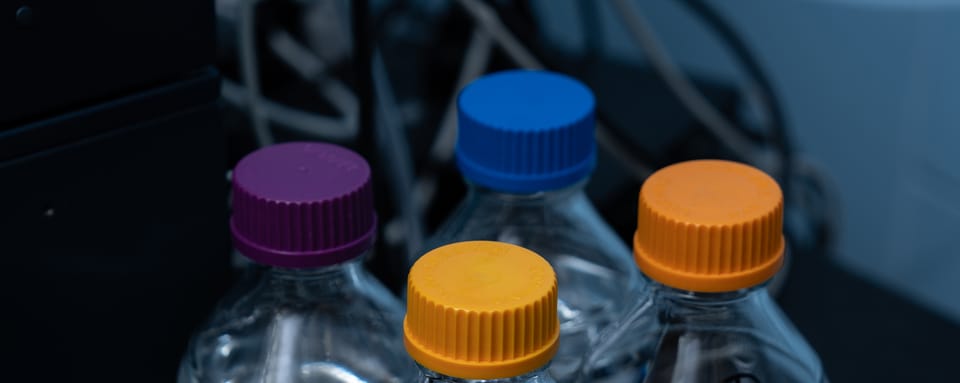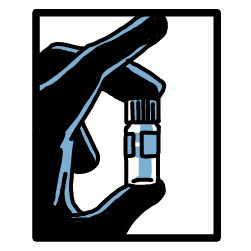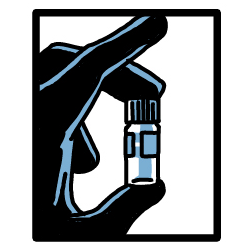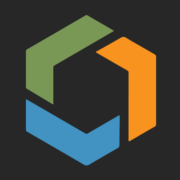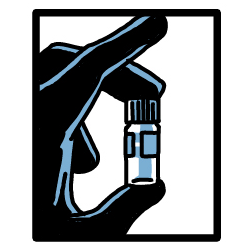The substance has been identified as:
bis(2,2,6,6-tetramethyl-4-piperidyl) sebacate
Abbreviation: BTMPS ("bee-temps")
Brand name: Tinuvin® 770
Industrial uses: UV-blocking component added to plastic, candle fragrance, adhesive for food stickers
Health Risks
Highly noxious; not psychoactive. Unusual taste, cough, blurry vision. Burning sensations reported when injected. Manufacturer toxicity studies suggest very low overdose risk. A screen against hundreds of human brain/body receptors suggests no binding to major psychoactive drug receptors.
Along with colleagues in harm reduction, we are investigating the emergence of this substance. This page is updated as we gather new information. All content on this page can be shared.
Table of Contents
- Background
- Chemical Identity (pronunciation, MW, names)
- MSDS (safety info from manufacturer)
- Industrial Uses (plastic, fragrance)
- Timeline
- UNC Samples (live data)
- Sensation Reports
- Spectra (FTIR and GCMS)
- Pharmacology
- Manufacturer Toxicity Studies obtain via FOIA from FDA
- Scientific literature
- Interpretation (facts, alt hypotheses, what we don't know)
- Talking points (for media and harm reduction)
- Drug alert (Canva, PowerPoint, etc. and style guide)
Updates
December 20, 2024
More results from the amazing XP Huang at UNC. There had been some older papers suggesting that BTMPS had antagonist properties at nicotinic acetylcholine receptors (nAChRs). Using modern assays, XP now reports no binding activity whatsoever of BTMPS to nACHRs. So, think twice before making broad claims about molecular properties of BTMPS based on old papers who's findings were never reproduced.
November 26, 2024
A national team of drug checking collaborators figured out why the FTIR spectra for BTMPS isn't aligning with the reference standard!

November 17, 2024
Pittsburgh Post-Gazette does a solid job on this article about BTMPS, quoting many experts from our drug checking community.
October 18, 2024
We have confirmation back from XP Huang that BTMPS does not meaningfully activate any of the ~350 brain and body (G protein-coupled) receptors usually associated with psychoactive drugs. This was via the PRESTO-TANGO assay. Remember back on September 26th we noted blips at 3 receptors that could indicate some low level binding? One of those was GPR151, which is believed to modulate neuropathic pain. GPR151 is highly expressed in the brain region habenula and is implicated in at least a couple of studies in addiction vulnerability; one current study proposes to develop a GPR151 antagonist as a treatment for opioid use disorder. So we wanted to see if GPR151 could be associated with the albeit rare reported positive sensations.
Therefore, XP conducted a dose-response profile at GPR151: The finding was no agonist activity. XP will look at opioid modulating effects next, e.g., combining fentanyl with BTMPS at the same time. But thus far, none of the brain/body receptor hypotheses for BTMPS seem to doubtful. This looks nothing like a controlled substance. We hypothesize that reported physiological sensations from BTMPS is likely coming from the co-occurring fentanyl or through the general side effect of "delirium" noted with pharmaceutical calcium channel blockers.
October 1, 2024
NPR mentions BTMPS in a broader article about drug supply shifts.
September 27, 2024
Alice Bell in Pittsburgh brought to our attention that they had seen BTMPS (albeit as trace) in a a yellow fake Xanax pill that was bromazolam, without fentanyl. Then we saw this result of a fake blue M30 from New Mexico that contained BTMPS and acetaminophen with no fentanyl.
What do these tell us? Are they one-offs? Who has motive and access to replace fentanyl with an aversive agent?
September 26, 2024
We got results back from XP Huang @ UNC. He ran BTMPS in the PRESTO-TANGO assay at 10µM concentration and found no significant binding activity to 320 brain/body receptors that drugs usually activate. There were very small blips at GPR151, HCA3, BB3, but did not rise to the level of binding signal. Interpretation: BTMPS doesn't appear to have psychoactive activity across a large range of known human drug receptors.
September 24, 2024
WRAL out of Raleigh covers BTMPS after it was found in Edgecombe County, North Carolina.
September 18, 2024
Washington State Drug Brief from ADAI
September 16, 2024
New article in Los Angeles Times. First national news coverage.

The pre-print for the Shover et al. scientific article referenced in the news piece is below.

September 10, 2024
Over the summer we filed a Freedom of Information Request with the US Food and Drug Administration to obtain the toxicology studies filed by the manufacturer of Tinuvin® 770 in order to get it approved to be an additive in adhesives and pharmaceutical-grade plastics. Most of the documents are from 1975-76 CE.
Key revelation: Manufacturer studies suggest very low overdose risk with oral LD50 3,700 mg/kg

Background
Subjective reports from participants are mixed. Burning sensation upon injecting, heavy coughing, and a chemical smell have been reported. We have not heard of widespread overdoses, but a handful were reported from one location but mixed with other substances and not verified. Unexpected, possible subjective overlap with fentanyl in terms of sensation have been reported in one site, but overall the reaction is very negative.
The compound is not a controlled substance, and had not previously been identified in the drug supply. Its cardiac toxicology was researched in the 1990s and early 2000s, growing out of concern from leeching out of plastics used in pharmaceutical packaging.
Chemical Identity
Description: Hindered amine light stabilizer used in pharmaceutical plastics to block UV rays.
Chemical names
- bis(2,2,6,6-tetramethyl-4-piperidyl) sebacate
- decanedioic acid bis(2,2,6,6-tetramethyl-4-piperidinyl) ester
- bis(2,2,6,6-tetramethylpiperidin-4-yl) decanedioate
Abbreviations: BTMPS, bis-TMP
Brand names: Tinuvin 770, Ultradur® - manufactured by BASF
Pronunciation
Here's a phonetic pronunciation guide for bis(2,2,6,6-tetramethyl-4-piperidyl) sebacate:
[bis (2, 2, 6, 6-tet-ruh-meth-uhl-4-pi-per-i-dil) seb-uh-kate]
Breaking it down:
- bis: [bis]
- (2,2,6,6-tetramethyl-4-piperidyl): [(2, 2, 6, 6-tet-ruh-meth-uhl-4-pi-per-i-dil)]
- sebacate: [seb-uh-kate]
The stress in "tetramethyl" is on the second syllable: te-TRA-meth-yl.
The stress in "piperidyl" is on the second syllable: pi-PER-i-dyl.
The stress in "sebacate" is on the first syllable: SEB-uh-kate.
Chemical Listings
PubChem CID: 164282
IUPAC: bis(2,2,6,6-tetramethylpiperidin-4-yl) decanedioate
CAS: 52829-07-9
UNII: 6803A71201
EPA: DTXSID0028030
ECHA: 258-207-9
SMILES: CC1(C)CC(CC(C)(C)N1)OC(=O)CCCCCCCCC(=O)OC1CC(C)(C)NC(C)(C)C1
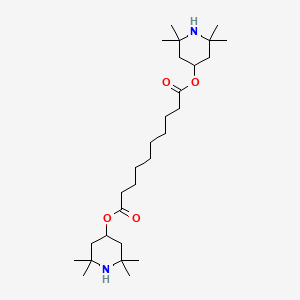
Molecular Weight
Exact mass (via PubChem): 480.39270814 g/mol
MW: 480.7 g/mol
CSFRE Monograph
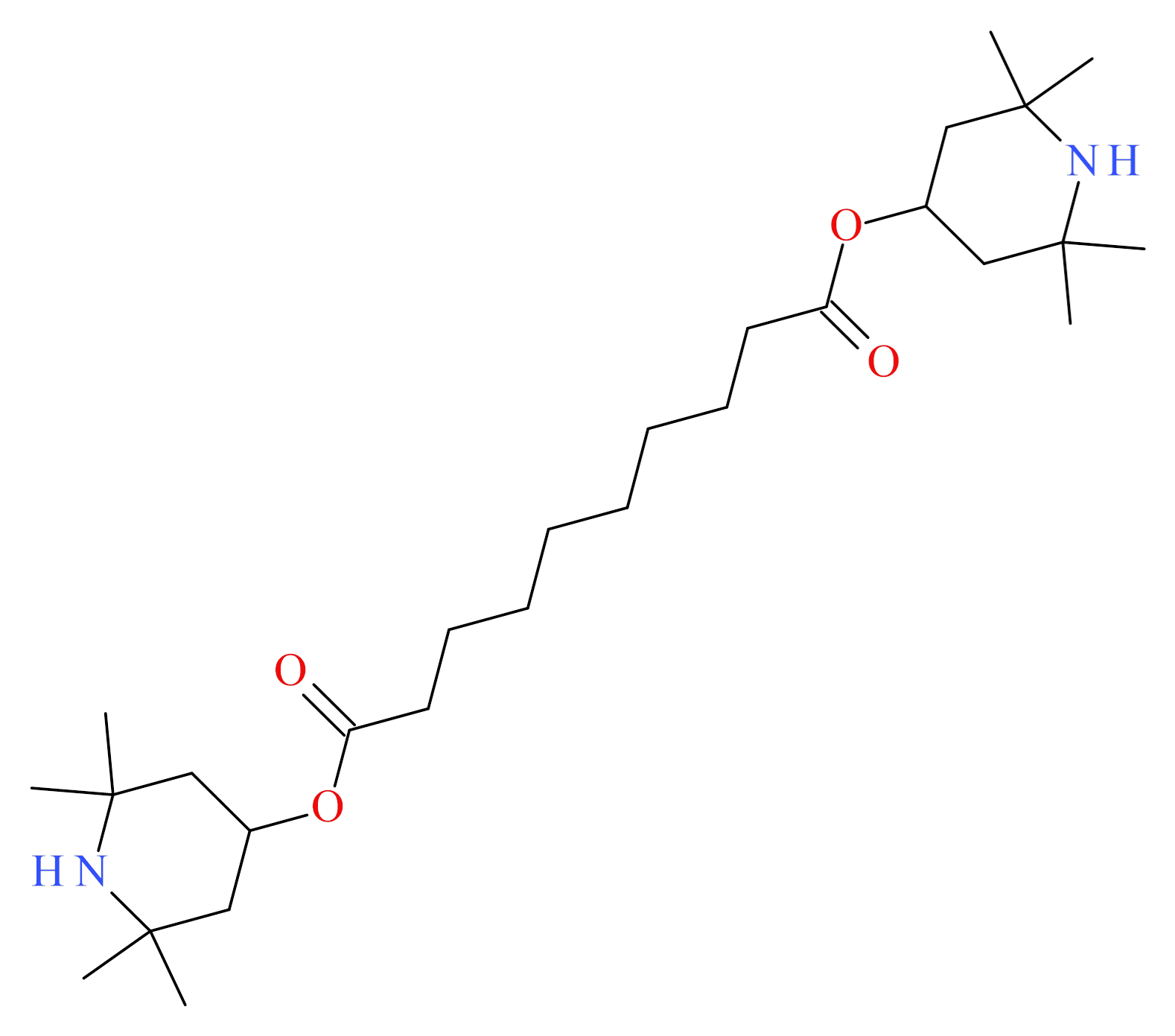
MSDS
Safety information sheets from the manufacturer.

Industrial Uses
The European Chemicals Agency lists the following as uses for the substance:
This substance is used in the following products: coating products, adhesives and sealants, fillers, putties, plasters, modeling clay and air care products.
Other release to the environment of this substance is likely to occur from: indoor use (e.g. machine wash liquids/detergents, automotive care products, paints and coating or adhesives, fragrances and air fresheners) and outdoor use.
This is consistent with what is known in the US. The US EPA lists it as a component of Glade Candle Sheer Vanilla Embrace. The International Fragrance Association lists it as a component of commercial fragrances, and EPA categorizes it as a fragrance.
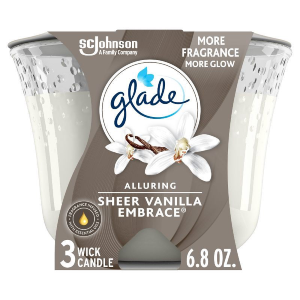
The major chemical manufacturing company BASF lists it on their website too.

Timeline
- In mid-June, Blake Joachim at OutsideIn in Portland, Oregon identified an unknown substance via FTIR. We received the sample the following week at UNC. Initially, we were unable to make a GCMS library match for the peak. Sharing scan information with CSFRE, they also confirmed that they had seen it and putatively suggested it might be bis(2,2,6,6-tetramethyl-4-piperidyl) sebacate. We decided to order a reference standard to make a definitive match.
- In the meantime, a total of 7 harm reduction programs also detected the substance via FTIR. Many email conversations were occurring with local pharmacology experts.
- In conversations with harm reduction programs, fentanyl-experienced participants described sensations consistent with a quasi-substitution effect for fentanyl. We use these terms loosely!
- In mid-July, UNC Street Drug Analysis lab obtained a reference standard of pure bis(2,2,6,6-tetramethyl-4-piperidyl) sebacate, and Erin Tracy made a definitive determination on July 22, 2024 of the identity of the substance. We are now confident about the identification.
- The reference standard was provided to X-P Huang at UNC to run on the PRESTO-TANGO assay to determine GPCR binding sites, i.e., which human body receptors the substance actually binds to. Findings reveal essentially no binding at psychoactive receptor sites in human brain and body.
- The FTIR and GCMS spectra were uploaded to this page and shared with the ACDC community the first week of August.
- During August 1, 2024 ACDC call some key information was shared:
- Earliest suspected samples from programs were June 4th in Los Angeles, and June 16 in Philadelphia.
- Some cases of deaths-after-ingestion of mixtures containing bis(2,2,6,6-tetramethyl-piperidyl sebacate were reported in Philadelphia. (note: we do not get samples from Philadelphia)
- It has been detected in 6-8 different stamps from Philly.
- More than half the samples from Portland, OR tested locally with FTIR contained the substance, but wasn't showing up in the fake M30 pills.
UNC Samples
The live report linked below lists all the samples we have seen containing bis(2,2,6,6-tetramethyl-4-piperidyl) sebacate.
Data table displays best in separate window.
Sensation Reports
Shared with individual participant permission.
Sampleid 805770 (7/3/24): "'Fish dope', smells like fish when smoking it."
Sampleid 805374 (6/14/24): "Client reported that this batch was much stronger than previous. Client stated that they got high off smoking only one hit and that was rare. Client typically injects in neck and describes tolerance as very high."
Sample 805700: "Client stated sample was 'good fentanyl, light, powerful, chemical aftertaste. Very white. Client described taste as lingering, tasting like chemicals, acetone, or bug spray."
During the ACDC call on August 1, 2024, the following sensations were consistently described from participant experiences.
When smoked
- Ears ringing
- Vision blurred
- Hard coughing, coughing blood when smoked
- Unusual taste (when smoked): "bug spray", "plastic", "adhesive"
When injected
- burning sensations
- weird; weaker and stronger than fentanyl; unpleasant
- vein rigidity at site of injection was discussed on ACDC
- But also, rare pleasant feelings among experienced fentanyl users have also been reported.
Spectra
FTIR Spectra
Screenshot from UNC FTIR based on pure reference standard:

Published FTIR spectra from the Wiley spectral database:

FTIR File
What’s up with the IR spectrum of BTMPS? How come the literature spectrum doesn’t fit what we are seeing in drug samples?
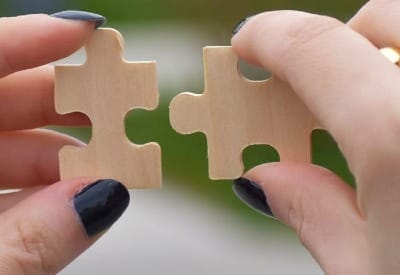
And here is the protonated spectra that will be more apt to line up with BTMPS in street samples, courtesy of Vikrant Jandev and Marya Lieberman at the University of Notre Dame:
For the sake of completeness, the pure reference standard FTIR spectra is here:
From FTIR technician Blake in Portland, Oregon, the file below may be useful for technicians because it is mixed in with other substances and is more representative of how it appears on the street. See also the corresponding GCMS for this sample. (shared with permission)
GCMS
GCMS Screenshots of retention time and fragmentation pattern:

GCMS File
Pharmacology
Predicted receptor targets
From Bryan Roth @UNC on July 11, 2024. These are predicted binding sites based on molecular structure.

Receptor screening
List of receptors the substance has been screened against. This indicates that opioid receptors have not been previously considered as a potential binding site for bis(2,2,6,6-tetramethyl-4-piperidyl) sebacate.
Calcium Channel Blocker
The substance is believed to be a L-type Ca(2+)-channel blocker.
FOIA Toxicity Studies

Scientific Literature
Thanks to Adams Sibley @ UNC for running the lit review! Missing something? Let us know opioiddatalab@unc.edu.
Epidemiology
The pre-print for the Shover et al. article on the state of the 2024 outbreak.

Health effects: Heart and skin
- A light stabilizer Tinuvin 770-induced toxic injury of adult rat cardiac myocytes
- Comparative Study on Cardiotoxic Effect of Tinuvin 770: A Light Stabilizer of Medical Plastics in Rat Model
- First Evidence of Hindered Amine Light Stabilizers As Abundant, Ubiquitous, Emerging Pollutants in Dust and Air Particles: A New Concern for Human Health
- Hemodynamic Effects of the Light Stabilizer Tinuvin 770 in Dogs In Vivo
- Contact allergy to Tinuvin 770, a hindered amine light stabilizer in sandals contributing to hyperkeratotic foot dermatitis
Contamination
Pharmacological effects
Pharmacological effects: Nicotinic acetylcholine receptor antagonism
- Inhibition of nicotinic acetylcholine receptors by bis (2,2,6,6-tetramethyl- 4-piperidinyl) sebacate (Tinuvin 770), an additive to medical plastics.
- Functional Central Nicotinic Acetylcholine Receptor Antagonism by Systemic Administration of Tinuvin 770 (BTMPS)
- A light stabilizer (Tinuvin 770) that elutes from polypropylene plastic tubes is a potent L-type Ca(2+)-channel blocker
- Muscle-type nicotinic acetylcholine receptor delta subunit determines sensitivity to noncompetitive inhibitors, while gamma subunit regulates divalent permeability
Implications for dependence
- The use-dependent, nicotinic antagonist BTMPS reduces the adverse consequences of morphine self-administration in rats in an abstinence model of drug seeking
- Novel bis-2,2,6,6-tetramethylpiperidine (bis-TMP) and bis-mecamylamine antagonists at neuronal nicotinic receptors mediating nicotine-evoked dopamine release
- The α3β4* nicotinic ACh receptor subtype mediates physical dependence to morphine: mouse and human studies
Interpretation
This is our current thinking, including hypotheses and scientific speculation. Nothing below should be seen as firm conclusions. We good?
Observations
- The substance is showing mostly mixed with fentanyl, with the exception of one sample by itself in Los Angeles, and one mixed with xylazine in Oregon.
- We are not seeing consistent overdose reports with this substance, even when mixed in with other drugs. But reports out of the mid-Atlantic may suggest otherwise.
- The substance was detected from southern CA to Seattle, from Oregon to Michigan to New York, all within a month.
- Harm reduction drug checking programs picked this up before it showed up in post-mortem toxicology or law enforcement data.
- Reports from participants suggest some liking of the substance, and that it may have some substitution (very loosely defined!) effect for fentanyl. But this bears further characterization before we jump to conclusions. We also note that unexpected sleepiness was noted by participants. For the most part the experiences have been very negative.
- Many participants noted it has a distinct unpleasant smell. It’s interesting to note that it is used as a fragrance in air fresheners and candles.
- MSDS list it as an eye irritant.
Updates since original publication:
- August 23, 2024. We noticed that BTMPS was found in over a dozen fake blue M30 samples in Denver (806231, 806750, 806629, etc.). A few samples from New Mexico were also fake M30s, but as of now we aren't seeing BTMPS in fake pills elsewhere.

Our Current Thinking
- The substance appears to be incorporated into local drug preferences, such as Michigan having diphenhydramine also in samples (805660, 804976), but bis(2,2,6,6-tetramethyl-4-piperidyl) sebacate was only seen in trace amounts and also co-occurring with fentanyl. This suggests that it most likely that the substance entered the supply chain along with fentanyl. Local producers may be repackaging it unknowingly when bagging up fentanyl. Similarly in NY samples (804945, 805518) where the local supply is consistently characterized by the presence of procaine, samples containing bis(2,2,6,6-tetramethyl-4-piperidyl) was seen with procaine.
- Initially west coast samples had levels of bis(2,2,6,6,-tetramethyl-4-piperidyl) that were higher than elsewhere. In June, it was only detected in trace abundance in samples from NY and MI, whereas it showed up as a primary substance in the west coast samples from the start. By mid-July it had shown up as primary in a NY sample (804945). This may represent an initial dilution of an upstream-contaminated fentanyl supply as it moved west-to-east across the country, but it’s presence as a component of street dope may be increasing. We urge caution in interpreting these patterns since we are biased by what we see.
Alternative hypotheses
- Given it’s use in plastics, we have to rule out that the substance is appearing as a contaminant from plastic containers used to store street drugs. The single peak sample provides some credence to this being an intentional additive at least in one instance.
- It’s earlier characterization as a calcium channel blocker suggests human physiological effects could be similar to Rx medications that use this mechanism. Instead of presuming any “fentanyl-like effects” we need to understand the nuance of the subjective experience of people who use drugs, especially in samples where the substance is the only compound detected.
Calcium channel blockers are medicines used to lower blood pressure. They stop calcium from entering the cells of the heart and arteries. Calcium causes the heart and arteries to squeeze more strongly. By blocking calcium, calcium channel blockers allow blood vessels to relax and open.
Some calcium channel blockers also can slow the heart rate. This can further lower blood pressure.
- Mayo Clinic
What we don’t know
- We don’t if there is overdose risk. EVERY substance at some volume will be toxic.
- We don't know if naloxone (or any other antagonist) will act on it.
- We don’t know if this substance alone causes euphoric effects.
- We don’t know where this is coming from, or how it spread so quickly.
- We don’t know if this is being manufactured clandestinely or sourced from chemical manufacturers.
- We see no reason to jump to scheduling this substance.
Talking Points
Acknowledge the uncertainty.
Don't have your guess become misinformation.
Do not say anything you'll have to walk back later.
- This is a substance that should be avoided.
- It is being found primarily mixed with fentanyl.
- BTMPS is not a controlled substance. We have established in new experiments conducted in Fall 2024 that it does not bind to any psychoactive receptors in the brain or body.
- The known science is decades old. It is largely limited to rodents. We don't know everything it does in the human body. The one thing that has been established is that it is a calcium channel blocker, which means it lowers blood pressure.
- Involvement in a handful of overdoses has been hypothesized, but always in conjunction with fentanyl and other substances. Medical examiners do not assay for this substance in post-mortem toxicology, so overdose data are unavailable. Until there is a validated autopsy test, for the foreseeable future overdose data will be unreliable.
- It has moved rapidly this summer, and been confirmed in samples from Los Angeles, Portland, Seattle, Michigan, Pennsylvania, and New York. It may be in other places.
- For harm reduction providers, it is sufficient to say that an "industrial chemical is being found in the drug supply, come get your dope tested."
- Complications from smoking drugs contaminated with have been reported. If you're having hard coughs, bloody coughs, or noticing a fishy or chemical smell, get your drugs tested and avoid that batch.
- The unregulated drug supply is constantly changing. Harm reduction drug checking programs were the first to detect and identify this harmful additive. This demonstrates the importance of drug checking as a public health paradigm.
- This is a wholly predictable outcome from the War on Drugs. New and more dangerous substances continually emerge.
What not to do
- Do not speculate on pharmacology (e.g., smooth muscle tissue, nicotinic receptors, etc.) based on PubMed searches of old studies. Almost no medical toxicologist or law enforcement will have expertise. They too are guessing.
- Do not call it Tinuvin to media or participants. It's a handy name, but online searches for "tinuvin" won't provide useful information because it goes by other brand and scientific names.
Drug Alert
Alerts are brief. Encourage participants to come in and talk to you so you can provide them with the most current information.
Our health message communication studies have revealed that less information on the alert is best for new adulterants during early phases to reduce unintended risk-seeking. Links to further information are helpful, but the initial alert needs to emphasize the downsides in plain language.
These drug alert templates were created by health messaging experts Tushar Varma and Allison Lazard @ UNC, with illustrations by Brittain Peck. They are open source and can be modified for your local needs. Here are the links to the full set of Canva templates and Canva examples if you want a different look. Other file formats available: PowerPoint, InDesign, Illustrator.
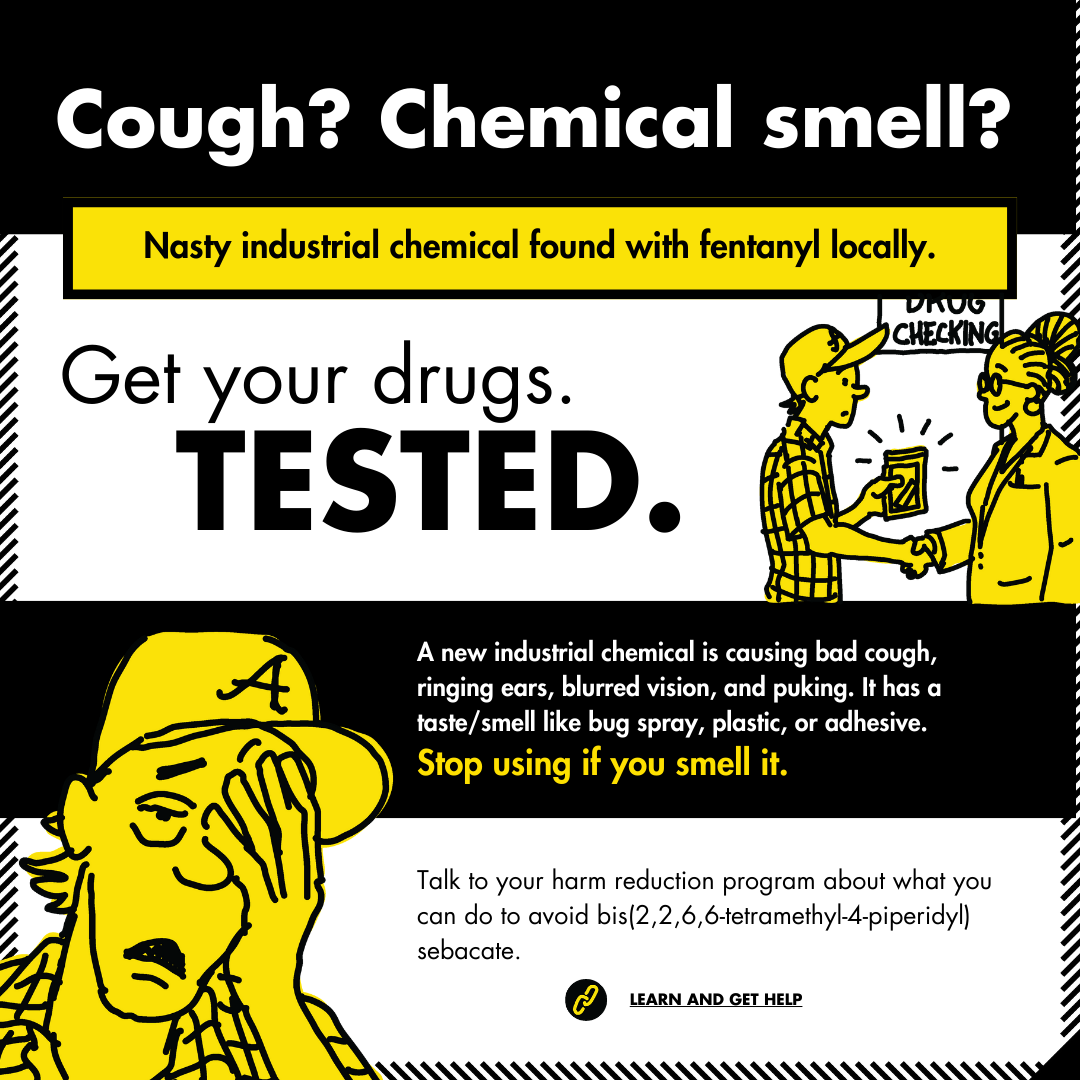
License
Drug alert for bis(2,2,6,6-tetramethyl-4-piperidyl) sebacate by Tushar Varma, Brittain Peck, Allison Lazard, Nabarun Dasgupta is marked with CC0 1.0 Universal

